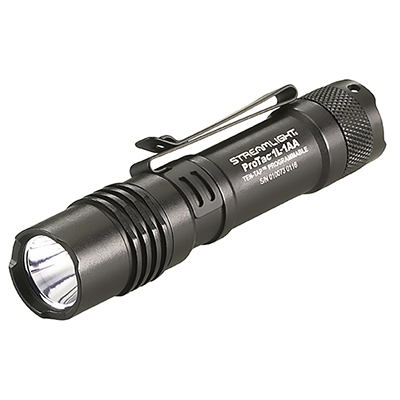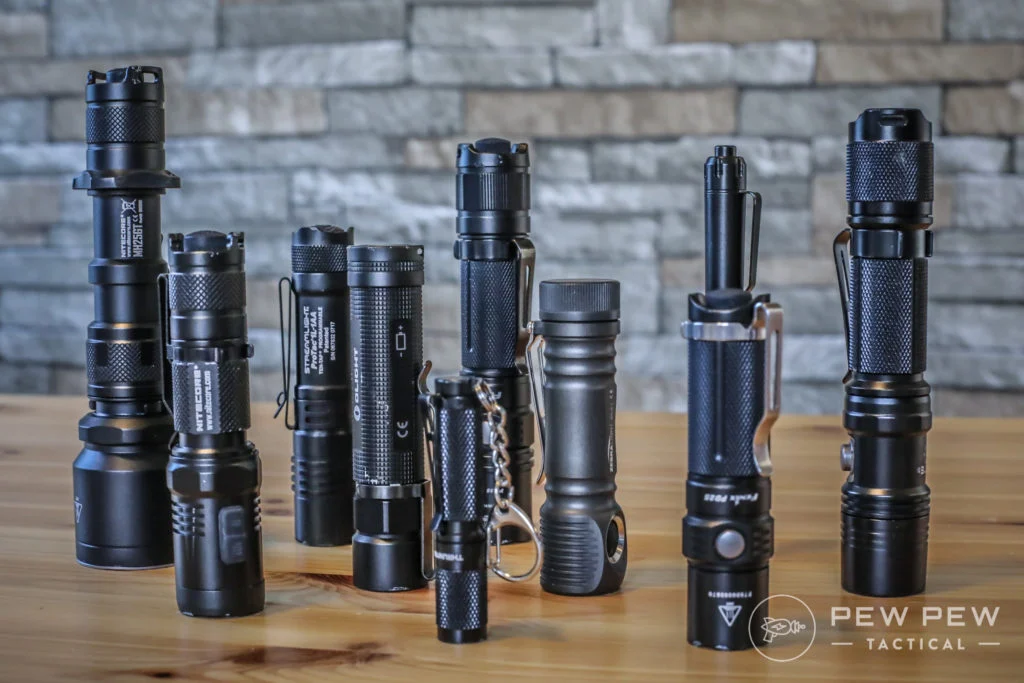Another question we get asked on a regular basis is what other EDC gear do we recommend overall. Personally; I like a tactical flashlight. “What exactly is a tactical flashlight?” To answer this question as simply as possible; a tactical flashlight has the below listed features that set it apart from most other flashlights that are commonly found at a hardware or convenience store:
- A bezel that may or not be scalloped which sticks out further than the glass which protects the bulb. These not only provide additional protection to the glass itself but can also be used a weapon to strike a target or opponent without damaging the flashlight.
- A tail-switch (instead of only a switch on the side) that either provides a single function or that is predictable. let me explain that statement: There are a lot of cheaply made flashlights that have a multifunction switch at the tail end which can cycle between high, low, strobe outputs. The problem with these cheap ones is that every time you push the button; the flashlight will turn onto the next mode. So maybe you had it on the high setting and wanted to turn it back on expecting the high setting, but instead it turns onto the low setting. This would be considered an unpredictable switch; never knowing what mode the light is going to be on when you activate it. This can be a problem in an emergency or survival situation if you need the brightest setting in a hurry. Look for a flashlight that has a predictable switch or a flashlight that has a on/off switch AND a mode switch.
- Light output: A proper tactical flashlight needs to have at least 400 lumens of light output (not to be confused with LM’s) to temporarily blind the human eye or to actually see a relatively far enough distance to identify a potential threat. When looking at brightness ratings; pay attention to the hotspot rating (intensity and candlepower) which will tell you how good of a distance and center spot the flashlight will have. Look for something that is rated at least 15,000 – 35,000 candlepower beam intensity. Be weary of sellers advertising flashlights with obscene amounts of lumens (9,000 or 90,000) that only sell for $25.00. Most likely they are more like 200 lumens as it is impossible to have a hand light which puts out anything over 3,000 lumens with current technology. In that case…you get what you pay for.
- Price: spending a little extra on a quality tactical flashlight will be worth it in a sense that most of them will last years and years. A good price range to stay at is anywhere between $50 – $125 as there is no reason to spend more than that. I will post a few flashlight brands below that I have had personal experience with while working in law enforcement, military and armed security.
- Last point I want to make is to tell you to stay away from the flashlights that are “zoomable”. When a flashlight is listed a zoomable it just mean that the head of the flashlight can move back and forth to adjust the beam pattern. In theory; its a good idea but for practical use; more moving parts poses a problem in reliability and predictability. You don’t want to be turning on a flashlight with one hand in an emergency situation where you’ll need your other hand to adjust something else. This can be said for anyone whether you’re a law abiding citizen, military personnel, law enforcement or even a security officer.
Fenix Flashlights (dual buttons on the tail end or one button on the side for mode)


NiteCore Flashlights (dual buttons on the tail end)

Streamlight Flashlights (predictable multi-function tailswitch)

honorable mentions: Olight Flashlights, Klarus Flashlights
Just to be clear; Self Defense Grid is not endorsed or affiliated with any of the flashlight brand or manufacturers listed in this article. These are our own opinions based on our experiences and testing. For additional reading; check out

